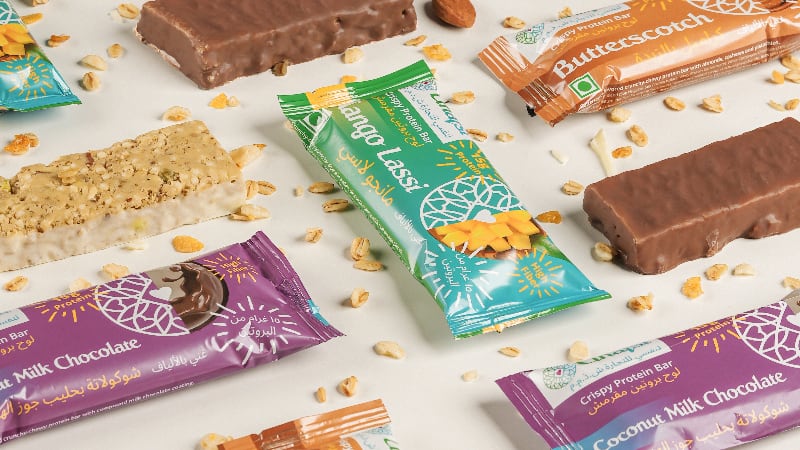Founded two years ago, the brand sought to create healthy snacks specifically for consumers in the Middle East. Yet, the venture comes at a time when a rapidly increasing number of players are entering the market.
“There are a few things that we are doing to stand out in this very competitive market. For one, we put a big emphasis on flavour. From the beginning, it was all about bringing unique and diverse flavours to the market. For example, our first product was a Mango Lassi bar, which is the first mango fruit-flavoured bar that I have seen [in this region].
“Especially since we have hot weather all year round, people like something fresh and light. As much as we are chocolate lovers, it can be a little too rich on days when it’s hot outside. If you are sweating a lot, you want something that’s refreshing,” founder Eve Lauren Heinz told FoodNavigator-Asia.
However, the brand did “compromise on the niche aspect” for one of its snack bar flavours, Coconut Milk Chocolate.
“We were trying to do something that hasn’t been seen much in the market but that is still a little traditional. We noticed that in grocery stores, people still love chocolate, so we can’t only do niche flavours; we need to have a range to appeal to different taste preferences.”
Additionally, Heinz shared that her team has been working on a baklava flavour for the past two years.
“It’s taken a very long time because when you are in the Middle East, you don’t want to get a flavour like this wrong. We have also been developing a pistachio orange flavour and a more classic peanut butter dark chocolate flavour.
“We can think of all sorts of unique flavours, but the question is: is it something that the market is even interested in and that people actually want? That’s what we are trying to figure out — consumer needs, likes and demands. Our approach is to do more sampling events and participating in events such as Dubai Fitness Challenge.”
For everyday consumers
Beyond fitness enthusiasts and gym-goers, Heinz is also targeting everyday consumers, including college students, parents, and working professionals.
“These people are often looking for convenience on the go. The goal is to give them an alternative high-protein, healthier snack that they could grab on a busy day when they may not get to sit down for a proper meal. It is extremely important that we make a product which blends great nutrition and great taste.
“For fitness enthusiasts, even if the taste isn’t great but the macronutrients are there, they would probably still eat the bar. But for the average consumer, that’s not going to work. We had to find that balance between nutrients like protein, whole food ingredients such as mango pieces, nuts and oats, and good taste.”
In response to feedback on traditional proteins being “dense and gritty”, Linafsi’s snack bars are designed to have a crispy texture and made using different protein sources.
“We don’t use artificial sweeteners like aspartame or sucralose because they are often associated with digestive discomfort and an aftertaste that people don’t really enjoy.”
Plans in the pipeline
Over the next year, Linafsi intends to continue refining its existing product line while expanding it.
“We are always product-focused. Even if you have a great brand, you need to back it up with good products so that consumers want to eat them. We are genuinely excited about the opportunities in this healthy food space, especially as we become more focused on supporting well-being, overall health, and active lifestyles.
“Apart from broadening our flavour range, we are working on adding gluten-free, vegan, and plant-based options to cater to more dietary preferences,” Heinz revealed.
At the same time, the brand looks to set foot into other categories, such as ready-to-drink protein beverages and children’s snacks.
“I would love to develop a healthier version of an energy drink because that seems to be a massive trend. In particular, what I’ve noticed at schools here is that there are very young people buying energy drinks.
“And you can’t really stop that — when it’s a trend, the young kids are going to go out and buy those energy drinks. But if I could make a healthier alternative that’s better for them, it would be great.”
Another area of growth that the brand is eyeing is the expansion of distribution avenues.
Heinz believes that both direct-to-consumer and HoReCa channels are crucial to thrive in the industry, as the former is key for sales volume and market presence, and the latter for building brand awareness.
“Grocery stores are important because that’s where most sales comes from and where people generally buy protein bars. However, it is also a very competitive channel. There are 100 bars along the snacks aisle, and it’s very difficult to make consumers pick yours just by the packaging alone.
“Therefore, we hope to enter more retail channels and find more unique sales channels. Right now, we are looking at getting into co-working spaces, hotels and spas, and gyms. Hotels, for instance, usually only work with one or two heathier snack brands, so we don’t have to vie with so many other competitors.”





